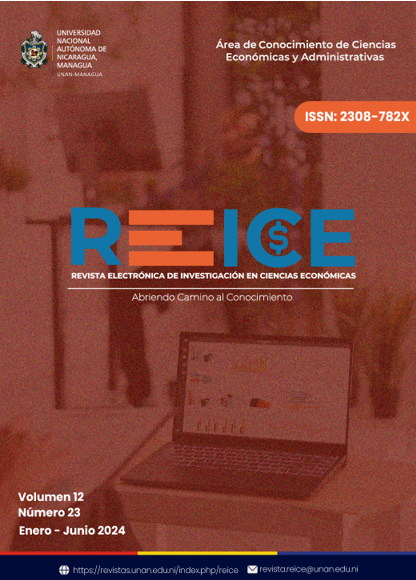Estimation of the optimal tax pressure in Nicaragua
DOI:
https://doi.org/10.5377/reice.v12i23.18294Keywords:
optimal tax pressure, tax collection, tax revenue, Laffer curveAbstract
In this work, the optimal level of tax pressure of the VAT, IR and ISC taxes of Nicaragua is estimated during the Period 2010 - 2021. Polynomial econometric models with covariates were used to estimate the optimal point in each tax, as well as sources of information secondary, estimating the tax pressure index, Laffer curve per tax. It is evident that the real tax pressure of indirect taxes, VAT and ISC, exceeds the fiscal optimum and that the tax pressure of IR is lower than the optimum with a behavior of reducing the gap between the optimal and real point. In conclusion, it was found by reducing the tax burden of indirect taxes VAT and ISC by increasing collections and that there is room for increasing IR without affecting economic activities.
Downloads
401
References
Aragón, A. E., & Zapata, F. d. (Noviembre de 2017). Obtenido de Repositorio UNAN-Managua: https://repositorio.unan.edu.ni/9164/1/18867.pdf
Asamblea Nacional. (18 de Febrero de 2014). Constitución Política de Nicaragua. Obtenido de Asamblea Nacional de Nicaragua: https://www.asamblea.gob.ni/assets/constitucion.pdf
Avendaño, N. (27 de Diciembre de 2020). La reforma tributaria rebasó la presión tributaria óptima. Obtenido de Blog de Nestor Avendaño.
Bahl, R. W. (Noviembre de 1971). A Regression Approach to Tax Effort and Tax Ratio Analysis (Analyse de l’effort et de la pression fiscale par la méthode de régression) (Un estudio del esfuerzo tributario y de la presión fiscal mediante el análisis de regresión). Staff Papers. Obtenido de JSTOR: https://www.jstor.org/stable/3866315
Barro. (1991). Economic growth in a cross section of countries. The quarlerty journal of economics. 407-443.
BCN. (2004). Producción. Managua.
BCN. (Mayo de 2010). La economía y el banco central. Obtenido de Banco Central de Nicaragua: https://www.bcn.gob.ni/sites/default//files/programas_educativos/educacion_economica/cuadernillos/La_Economia_y_el_Banco_Central.pdf
BCN. (Noviembre de 2020). Efectos de shocks de política fiscal en Nicaragua: evidencias de un análisis SVAR. Obtenido de https://www.bcn.gob.ni/sites/default/files/revista/volumenVII/Revista_Vol_VII_P2.pdf
BCN. (10 de 05 de 2022). Anuario de Estadísticas Macroeconómicas. Obtenido de https://www.bcn.gob.ni/divulgacion-prensa/bcn-publica-anuario-de-estadisticas-macroeconomicas-2021#:~:text=El%20Anuario%20es%20un%20compendio,particular%20para%20usuarios%20del%20%C3%A1mbito
Carrespi, M. T., & Elfenbaum, M. (Abril de 2016). LA CURVA DE LAFFER Y EL IMPUESTO INFLACIONARIO. Obtenido de http://www.economicas.uba.ar/wp-content/uploads/2016/04/5-La-curva-de-Laffer-y-el-impuesto-inflacionario.-Mar%C3%ADa-Teresa-Casparri-y-Melisa-Elfenbaum.pdf
Frank, H. J. (Junio de 1959). MEASURING STATE TAX BURDENS. National Tax Journal, Vol 12, N.2. Obtenido de JSTOR: https://www.jstor.org/stable/41790763
Laffer, A. (1 de June de 2004). The Laffer Curve: Past, Present, and Future. Obtenido de https://www.heritage.org/taxes/report/the-laffer-curve-past-present-and-future
LCT. (2012). Ley de Concertación Tributaria. Managua, Nicaragua, Nicaragua: La Gaceta Diario Oficial .
Mora, M. E. (2016). La Curva de Laffer como herramienta para la recaudación óptima en las entidades federativas de México. Ciudad de México.
Pérez, I. E. (Mayo de 2016). Las Teorías del crecimiento Economico . Obtenido de http://www.scielo.org.bo/pdf/rlde/n25/n25_a04.pdf
Zelada, A. M. (25 de Febrero de 2020). Análisis de la presión tributaria y su relación con la recaudación tributaria en el Perú periodo 2001 al 2018. Obtenido de https://repositorio.unsm.edu.pe/handle/11458/3681
Downloads
Published
How to Cite
Issue
Section
License

This work is licensed under a Creative Commons Attribution-NonCommercial-ShareAlike 4.0 International License.
Copyright (c) Revista Electronica de Investigacion en Ciencias Economicas
The rights to the articles published in REICE are from the journal, in order to be able to manage their best dissemination. However, since the purpose of the same is the dissemination of knowledge, this journal provides immediate free access to its content, under the principle that making research available to the public free of charge, which fosters a greater exchange of global knowledge.
The opinions expressed by the authors do not necessarily reflect the position of the publisher of the publication or of the UNAN-Managua. Its reproduction and distribution is authorized (in any type of support) provided that the following indications are fulfilled:
- The authorship of the work
- Indicate its origin (REICE magazine, volume, number and electronic address of the document)

